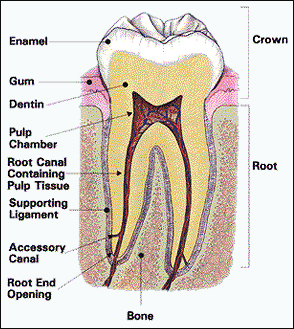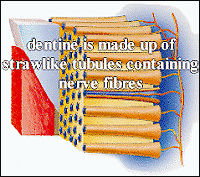At Hopedale Dental Care, Dr. Amit Chaudhry has included a diagram showing the anatomy of your tooth to help provide patients with a greater understanding of areas they should maintain to keep their oral health healthy.
Enamel
The shiny, hard white tissue covering the tooth is the strongest tissue in your body. It has to be! Your jaws place as much as 128 pounds of pressure on your teeth when you chew, bite, clench, or grind.

Dentin
This tissue makes up most of the body of the tooth. Even though dentin is hard and feels solid to the touch, it's actually microscopically porous and needs a covering of enamel or an artificial crown to protect it from decay-causing bacteria in your saliva.
Pulp
This soft tissue contains blood vessels, nerves, and connective tissue. The pulp provides nourishment for the tooth during growth and development. Once the tooth is mature, the pulp's only function is sensory. A fully developed tooth can survive without the pulp. If this tissue is damaged, your tooth can be saved with Root Canal Therapy.
Crown
This is the part of the tooth you can see above the gumline.
Root
This part of the tooth sits in the bone below the gum. Believe it or not, the root of your tooth is usually twice as long as the crown, the part you see above the gumline.
Gum
Dentists call this "gingiva". It covers the bone surrounding your teeth. When you brush your teeth after meals and floss daily, you keep this tissue healthy. That is important, because gum disease can cause bone lose. Gum disease can also expose the tooth roots to decay. If root decay affects the pulp, you may need root canal treatment.
Bone
The roots of your teeth are anchored by bone. Healthy teeth stimulate and keep bone tissue healthy and vice versa.
Periodontal Ligament
 Like the springs that hold a trampoline to its frame, this tissue supports the tooth and holds it in place in the bony socket surrounding the tooth. This tissue cushions both the tooth and the surrounding bone against the shock of chewing and biting.
Like the springs that hold a trampoline to its frame, this tissue supports the tooth and holds it in place in the bony socket surrounding the tooth. This tissue cushions both the tooth and the surrounding bone against the shock of chewing and biting.
Here you can see a close up of the tooth cut away seen above. The red is the gingiva or "gums". The white is enamel and orange is the dentin. The dentin is microscopically porous because it is made up of microscopic tubes or "tubules", inside of which are nerve fibres. If the enamel is removed and the tubules exposed, sensitivity results.
For more information on how to take care of your teeth, contact us or schedule an appointment with our Oakville dentists today!